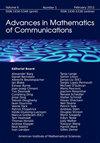On the number of factorizations of $ t $ mod $ N $ and the probability distribution of Diffie-Hellman secret keys for many users
IF 0.7
4区 计算机科学
Q3 COMPUTER SCIENCE, THEORY & METHODS
引用次数: 0
Abstract
We study the number
As a result, we derive a recurrence for
关于$ t $ mod $ N $的因数分解个数和多用户的Diffie-Hellman密钥的概率分布
We study the number \begin{document}$ R_n(t,N) $\end{document} of tuplets \begin{document}$ (x_1,\ldots, x_n) $\end{document} of congruence classes modulo \begin{document}$ N $\end{document} such that \begin{document}$ \begin{equation*} x_1\cdots x_n \equiv t \pmod{N}. \end{equation*} $\end{document} As a result, we derive a recurrence for \begin{document}$ R_n(t,N) $\end{document} and prove some multiplicative properties of \begin{document}$ R_n(t,N) $\end{document}. Furthermore, we apply the result to study the probability distribution of Diffie-Hellman keys used in multiparty communication. We show that this probability distribution is not uniform.
本文章由计算机程序翻译,如有差异,请以英文原文为准。
求助全文
约1分钟内获得全文
求助全文
来源期刊

Advances in Mathematics of Communications
工程技术-计算机:理论方法
CiteScore
2.20
自引率
22.20%
发文量
78
审稿时长
>12 weeks
期刊介绍:
Advances in Mathematics of Communications (AMC) publishes original research papers of the highest quality in all areas of mathematics and computer science which are relevant to applications in communications technology. For this reason, submissions from many areas of mathematics are invited, provided these show a high level of originality, new techniques, an innovative approach, novel methodologies, or otherwise a high level of depth and sophistication. Any work that does not conform to these standards will be rejected.
Areas covered include coding theory, cryptology, combinatorics, finite geometry, algebra and number theory, but are not restricted to these. This journal also aims to cover the algorithmic and computational aspects of these disciplines. Hence, all mathematics and computer science contributions of appropriate depth and relevance to the above mentioned applications in communications technology are welcome.
More detailed indication of the journal''s scope is given by the subject interests of the members of the board of editors.
 求助内容:
求助内容: 应助结果提醒方式:
应助结果提醒方式:


